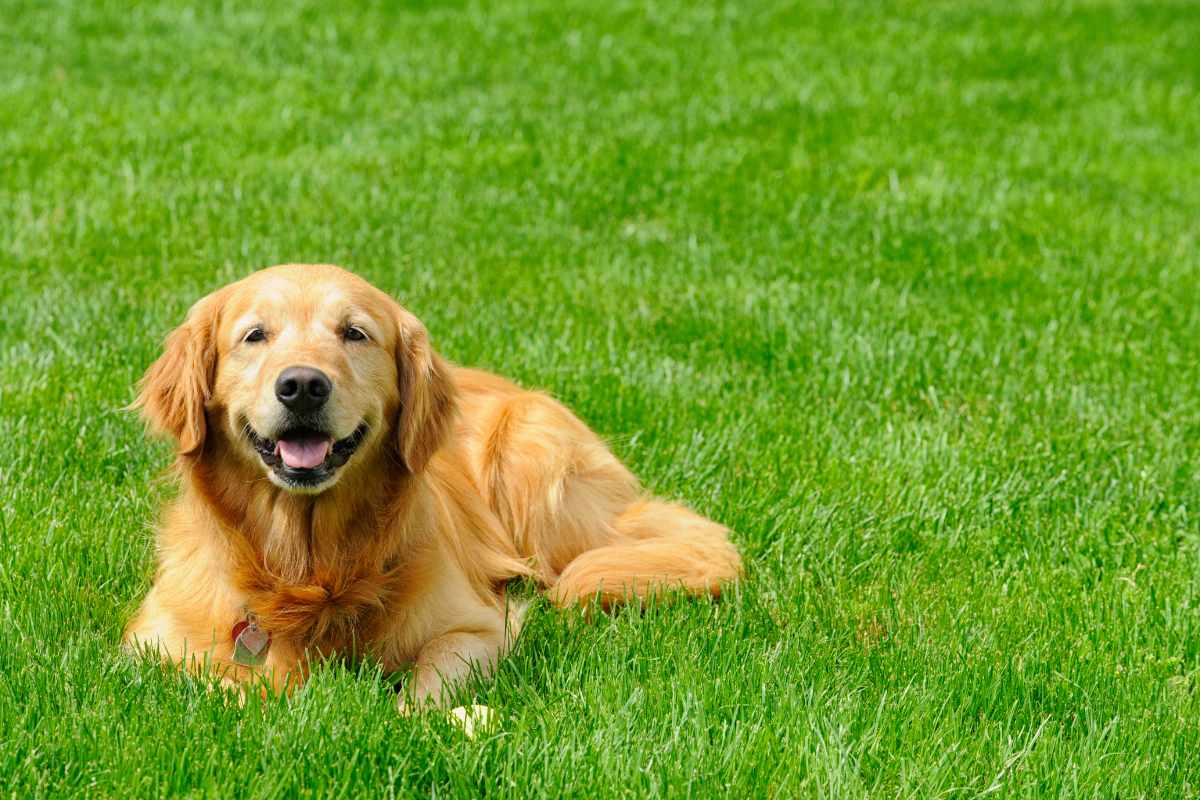
Every dog owner knows the lawn is more than just grass — it’s a playground for their beloved pup. However, between spirited play, digging, and the occasional urine spot, our furry friends can be tough on turf. The key to a lasting, vibrant lawn? Choosing the best grass for dogs, which can withstand the wear and tear of canine antics.
With the right grass, you can offer your pet the ideal play space while keeping your yard looking lush and lively. Read on to find out which grass varieties stand out as the top picks for pet owners everywhere.
Best Grass for Dogs Calculator
Recommended Grass Types for Your Yard
Bermudagrass
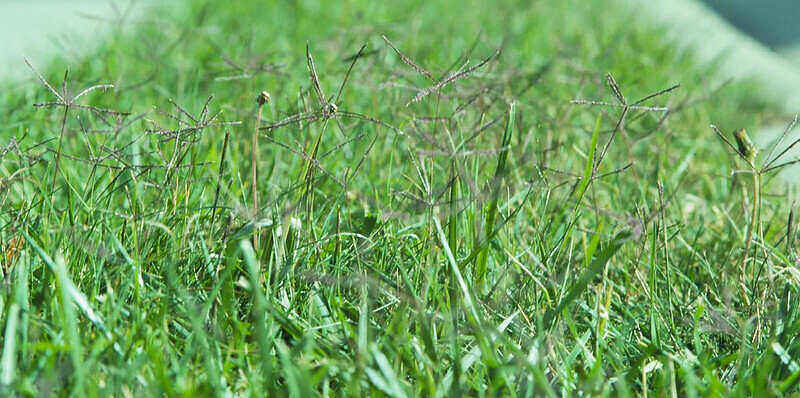
Photo Credit: Matt Levin / Flickr / CC BY-SA 2.0
Bermudagrass is a warm-season favorite among dog owners and prized for its resilience. Its high foot traffic tolerance, evidenced by its use on golf courses, ensures it can withstand the enthusiastic romps of our canine friends. This grass has a deep root system, allowing it to spread rapidly and heal from pet damage in record time.
Although Bermudagrass thrives in sunny environments, it struggles in shaded areas. Moreover, its rapid growth rate means that this grass requires frequent mowing to keep it looking tidy and well-manicured.
So, if you have a sunny yard and an active dog, Bermuda could be the ideal choice for a durable and beautiful lawn. Just keep in mind the mowing commitment.
Classification: Warm-season grass
Shade tolerance: Low; thrives in full sun
Drought tolerance: High
Foot traffic tolerance: High
Maintenance needs: Needs frequent mowing due to fast growth rate; develops thatch easily; needs regular fertilization
Mowing height: Set the mowing height between 0.5 and 1.5 inches for hybrid Bermudagrass cultivars. Mow common Bermudagrass down to 1.5 to 2.5 inches.
Potential for disease: Good resistance to disease, although diseases are common; low resistance to insects
Other notes: It will go dormant during winter, making it less resistant to dogs.
Grass Seed Options:
– Scotts Turf Builder Bermudagrass (10-lb. bag)
– Hancock Seed Co. Bermudagrass (50-lb. bag)
Centipedegrass
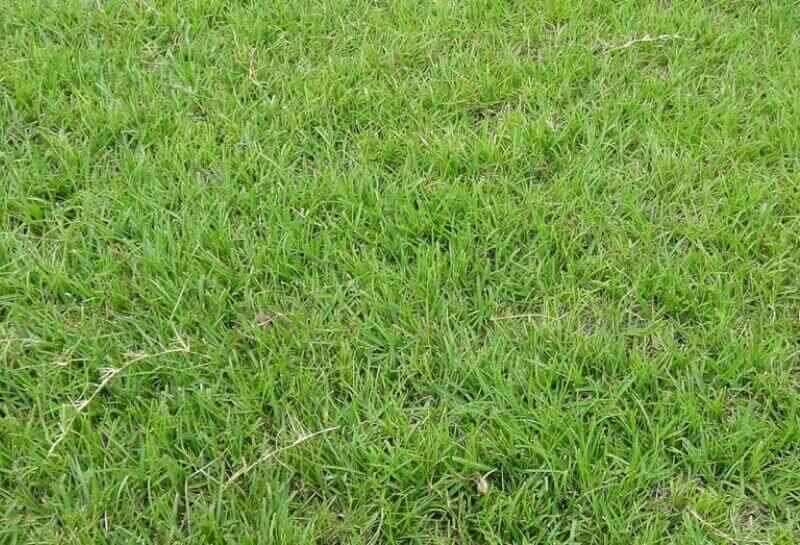
Photo credit: Michael Rivera / Wikimedia Commons / CC BY-SA 4.0
One of the highlights for dog lovers is centipedegrass’s soft texture. Dogs will love to roll, play, or simply lounge on this plush green carpet. What’s more, centipedegrass holds its own against dog urine, meaning those troublesome yellow spots won’t be an issue.
Centipedegrass, while beautiful and soft, is finicky when it comes to its growth conditions. For those ready to cater to its needs, however, the rewards are well worth the effort.
Firstly, ensuring your soil’s pH is on the acidic side is essential for centipedegrass to thrive. Alongside that, a well-draining soil bed is a must. While it may sound demanding, centipedegrass does have an upside: Once established in the right conditions, it becomes a resilient and low-maintenance lawn choice.
Classification: Warm-season grass
Shade tolerance: Moderate
Drought tolerance: Moderate
Foot traffic tolerance: Low
Maintenance needs: Needs plenty of water, which will also help dilute dog urine.
Mowing height: Set the mowing height between 1 and 2 inches.
Potential for disease: Good resistance to diseases and insects
Other notes: It has a slow-growing habit, which means you won’t be mowing it that frequently.
Grass Seed Options:
– Gulf Kist Coated Centipedegrass Seeds (1 lb.)
– Scotts EZ Seed Patch and Repair Centipedegrass (3.75 lbs.)
– TifBlair Centipedegrass (5-lb. bag)
Kentucky Bluegrass

Photo Credit: Shutterstock
If you live in a cooler climate and are looking for dog-resistant grass, Kentucky bluegrass might be the one for you. As a cool-season grass, it’s perfectly suited for areas that experience chilly winters, offering a lush carpet of green even when temperatures drop.
Kentucky bluegrass is tough and capable of withstanding the playful antics of energetic pups. It grows quickly once established, which allows it to heal rapidly, too. This grass also has a stunning blue-green color and a soft texture that makes it super comfy for your feet — and paws!
However, Kentucky bluegrass does come with a couple of caveats. Similar to Bermuda, it doesn’t fare well in shaded spots. Additionally, this grass type needs higher fertilization to stay lush and healthy.
Classification: Cool-season grass
Shade tolerance: Low
Drought tolerance: Moderate
Foot traffic tolerance: Moderate
Maintenance needs: Moderate mowing frequency and high fertilization needs.
Mowing height: Set mowing height between 2.5 and 3.5 inches.
Potential for disease: Moderate to high; prone to several diseases, such as dollar spot, leaf spot, necrotic ring spot, summer patch, and stripe smut.
Other notes: Does not tolerate high temperatures well.
Grass Seed Options:
– Jonathan Green (11970) Blue Panther Kentucky Bluegrass Grass Seed (3 lbs.)
– SeedRanch Midnight Kentucky Bluegrass Seed (5 lbs.)
Perennial Ryegrass
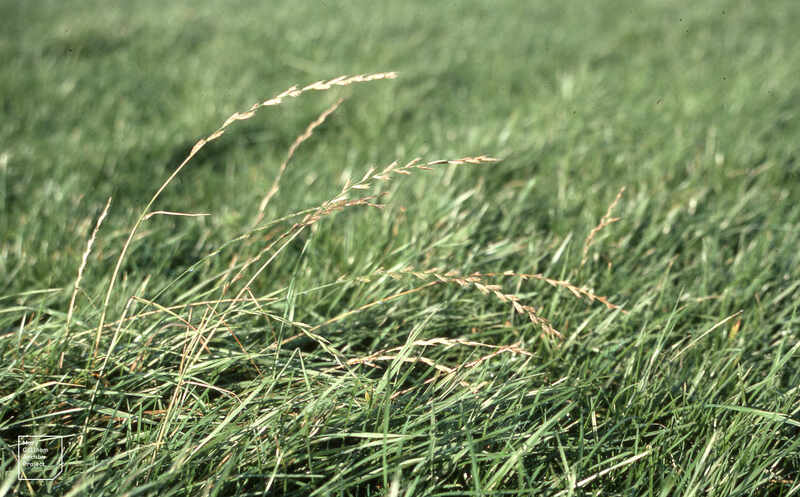
Photo Credit: Dr Mary Gillham Archive Project / Flickr / CC BY 2.0
Perennial ryegrass is a cool-season grass that has garnered attention, especially among dog owners, for a pretty neat reason: It stands up well to dog urine. If you’ve faced the challenges of those notorious yellow patches caused by your dog’s bathroom breaks, perennial ryegrass might be a game changer for you.
This grass sprouts quickly and is robust enough to handle high traffic, whether it’s children playing or dogs chasing balls. However, unlike Kentucky bluegrass, it’s not as resistant to extreme cold. Additionally, it doesn’t handle drought or shady conditions very well, so it needs a good balance of sunlight and regular watering.
But here’s the silver lining: Thanks to its fast growth, perennial ryegrass is an excellent choice for reseeding those dead spots in your lawn caused by dog damage or other factors. It can quickly fill in gaps and blend with other grasses in overseeding mixtures, giving your lawn a seamless look.
Classification: Cool-season grass
Shade tolerance: Low
Drought tolerance: Low
Foot traffic tolerance: High
Maintenance needs: Moderate mowing and fertilization requirements. Thatch is not significant.
Mowing height: Set mowing height to 1.5 to 2.5 inches
Potential for disease: High. Common diseases include gray leaf spot, red thread, and leaf spot/melting-out.
Other notes: This grass does not heal itself; it has to be reseeded.
Grass Seed Options:
– Outsidepride Perennial Ryegrass Seed (5 lbs.)
– Eretz ProTurf Perennial Ryegrass Fine Lawn Seed (choose your size)
Tall Fescue

Aaron J. Patton, Ph.D. / Turfgrass Extension Specialist at Purdue University
Tall fescue is another top choice for people living in cooler places with dogs. Its deep roots make it super resilient, so it can handle a lot of running and playing without getting damaged easily.
In addition, tall fescue’s deep roots help it during dry times, meaning it can go without water longer than some other grasses. And if your yard has some shady spots? No problem — it can handle a bit of shade.
But there’s one thing to keep in mind: Tall fescue grass has a bunch-type growth habit. This means if it does get damaged, it won’t fix itself like some other grasses do. If you see dead spots caused by your dog’s playing, you’ll have to overseed in the fall to fill them in.
Classification: Cool-season grass
Shade tolerance: Moderate
Drought tolerance: Moderate to High
Foot traffic tolerance: Moderate
Maintenance needs: Frequent mowing. Does not produce significant thatch.
Mowing height: Set mowing height to 2 inches when grass reaches 3 inches tall.
Potential for disease: Tolerant of most diseases when properly maintained.
Other notes: Needs overseeding to remain a dense mat.
Grass Seed Options:
– Triple-Play Tall Fescue Grass Seed Blend (5000 sq ft)
– Eretz Kentucky 31 K31 Tall Fescue Grass Seed (choose your size)
– Pennington The Rebels Tall Fescue Grass Seed Mix (7 lb.)
Zoysiagrass
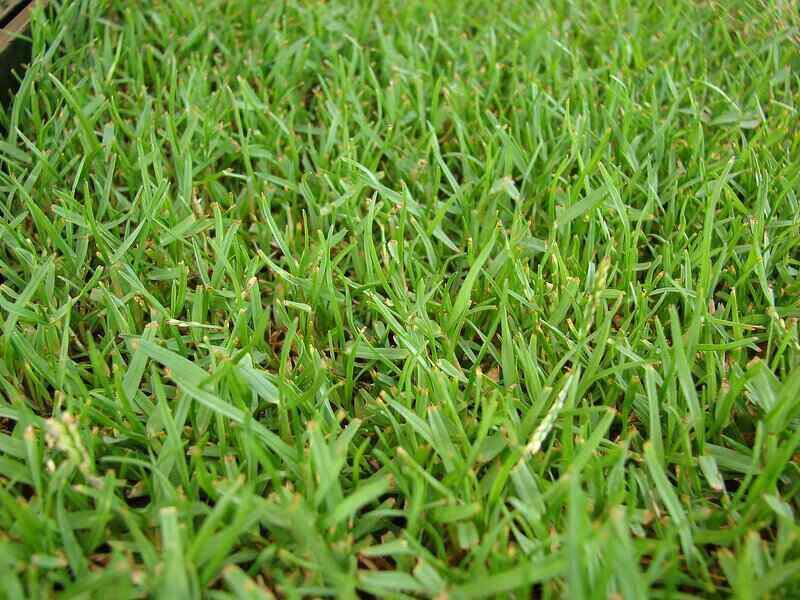
Photo Credit: Forest and Kim Starr / Wikimedia Commons / CC BY 3.0 US
For those in warmer climates, Zoysiagrass is an option worth considering if your dogs love to romp in the yard. This warm-season grass is known for its resistance to drought, meaning you won’t need to grab the hose frequently. Its soft texture is a pleasure underfoot, so dogs will surely appreciate lounging and playing on this turf.
Zoysia’s thick growth ensures a plush, carpet-like appearance that elevates any landscape. But while it’s durable and can handle the pitter-patter of doggy feet, there’s a catch: If it does get damaged, it’s a bit slow on the recovery front.
Another point to note is the patience required for Zoysiagrass. If you’re looking for a quick lawn transformation, this might not be your best bet. It can take anywhere from two to four years for this grass to fully establish and show its true potential. Plan to sod the lawn for quicker establishment.
Classification: Warm-season grass
Shade tolerance: Moderate
Drought tolerance: Moderate to High
Foot traffic tolerance: High, but recovers slowly from damage
Maintenance needs: Low nitrogen fertilization requirements, although it’s prone to thatch build-up.
Mowing height: Set mowing height between 1 and 2 inches.
Potential for disease: Good disease tolerance overall
Other notes: Zoysiagrass goes dormant during the cold season.
Grass Plug and Seed Options:
– Zoysia Plugs (50 Large Grass Plugs)
– Zoysia Plugs (50 Full & Lush Grass Plugs)
– Zoysia Plugs (100 Plugs)
– Zenith Zoysia Grass Seeds (1/8 lb. of seeds)
How to Choose the Best Dog-Friendly Grasses
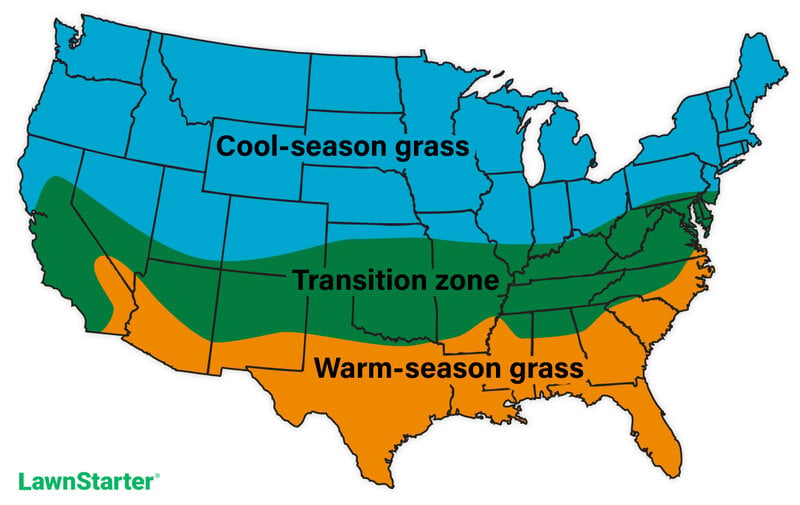
Knowing how to choose the right grass for your yard isn’t just about aesthetics. If you’re a dog owner, you know that it’s equally about durability, comfort, and safety for your four-legged friend. Here are some factors to consider when planning a dog-friendly lawn:
Climate
Your geographical location plays a pivotal role in determining the type of grass that will thrive. Grasses are broadly categorized into cold and warm-season varieties. Cold-season grasses flourish in cooler climates, while warm-season grasses are suited for warm weather.
If you’re situated in the transition zone — an area where conditions are a blend of both warm and cold — you might have a bit more flexibility in your choice. However, outside of this zone, it’s crucial to pick a grass type suited to your specific climate.
- Best warm-season grasses for dogs: Bermuda, Zoysia, and centipedegrass
- Best cool-season grasses for dogs: Kentucky bluegrass, tall fescue, and perennial ryegrass
Yard Characteristics
The physical layout and conditions of your yard play a substantial role. If your yard is dappled with trees casting shade throughout the day, a shade-tolerant grass type is essential. On the other hand, if your yard basks in sunlight, most grass varieties will likely fare well since all of them need sun exposure.
- Best shade-tolerant grasses for dogs: Zoysia, tall fescue, and centipedegrass
Maintenance and Time
Grass isn’t a “plant it and forget it” endeavor. Some varieties require frequent mowing, watering, and fertilizing, while others are more low-maintenance. Gauge the amount of time and effort you’re willing to invest in lawn care and choose a grass type that aligns with your commitment level.
- Best low-maintenance grasses for dogs: Centipedegrass
Dog-Resistant Features
Dogs, delightful as they are, can be tough on lawns. Choosing grass with a deep root system ensures it can withstand the wear and tear of paw traffic and playful romps. Additionally, grass that grows rapidly can recover faster from any potential damage, ensuring that your lawn will recover well even after the most energetic of play sessions or potty breaks.
See Related:
FAQ About Grass for Dogs
What Type of Grass is Most Resistant to Dog Urine?
Perennial ryegrass is often considered the most resistant to dog urine. Additionally, centipedegrass can be a good choice, especially since it requires frequent watering.
Other grasses on this list also have features that help them recover from or resist urine damage: Bermudagrass and Kentucky bluegrass self-repair, tall fescue has deep roots that strengthen it against stress, and Zoysia’s dense canopy helps prevent all of the urine from reaching the soil.
Remember, no grass is immune from urine damage. Other strategies, like creating a designated potty spot, may be necessary.
How Do You Revive Grass After Dog Pee?
For minor dog pee damage, grass often has the ability to recover on its own over time. One of the best immediate actions you can take is to dilute the affected area with water shortly after your dog pees on it. This helps neutralize the nitrogen content in dog pee, further reducing the risk of those unsightly yellow spots.
However, if the damage is more severe and the grass doesn’t seem to be bouncing back, your best bet at fixing your lawn with dog pee might be overseeding the bare spot with new grass. Overseeding is the process of planting new grass seeds directly over existing grass to promote thick growth and fill in damaged or thinning areas.
Is Artificial Grass Good For Dogs?
Yes, artificial grass can be a good and safe option for dogs. There are several benefits to using synthetic turf in areas frequented by pets:
- Ease of cleaning: Artificial grass is notably easy to clean, making it convenient for dog owners.
- Always green: Unlike natural grass, which can turn yellow or brown from dog poop or pee, artificial turf retains its vibrant color.
- Pest control: Synthetic grass can help deter pests such as mosquitoes, ticks, and fleas, which can be harmful to dogs.
- Hypoallergenic: Artificial turf will not give your dog any allergies, as most materials are hypoallergenic.
However, there’s a notable caution for pet owners considering artificial grass. During the summer, synthetic turf can become exceedingly hot, especially in direct sunlight. This elevated temperature can be harmful to dogs, potentially causing burns or discomfort to their paws.
If you have artificial grass and are letting your dog out on a hot day, it’s advisable to water the turf to cool it down. Before letting your dog play on it, place your own foot on the turf to gauge its temperature and ensure it’s safe for your pet.
When to Hire a Lawn Care Pro
Being a proud dog owner doesn’t mean you have to bid farewell to your dream of a healthy lawn. Balancing the playful escapades of your furry friend with a lush, green landscape is very much achievable.
If you’re unsure where to start or need some expert advice, consider hiring a lawn care professional. They can guide you in planting the best grass type or assist in treating any bare and brown spots left behind by your canine companion. After all, both your pooch and your lawn deserve the best care!
LawnStarter participates in the Amazon Services LLC Associates Program, an affiliate advertising program. LawnStarter may earn revenue from products promoted in this article.
Main Image Credit: cmannphoto / Canva Pro / License